
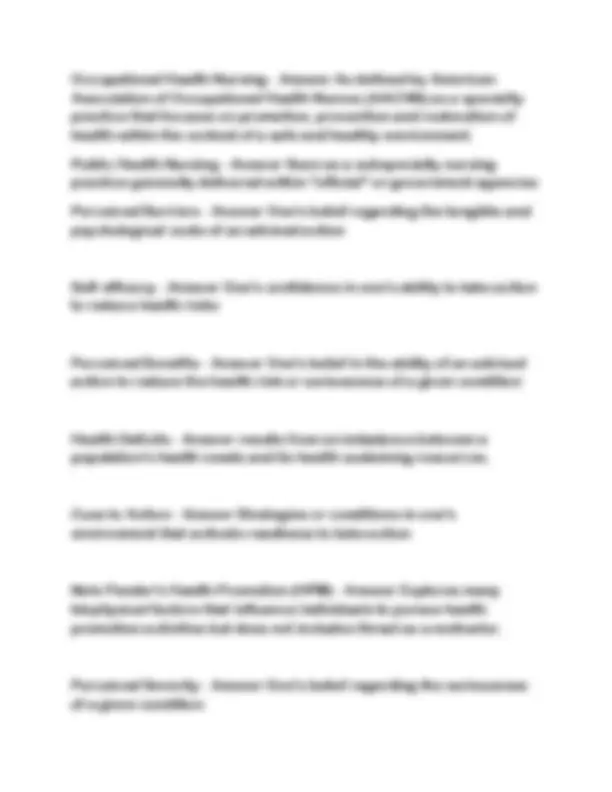
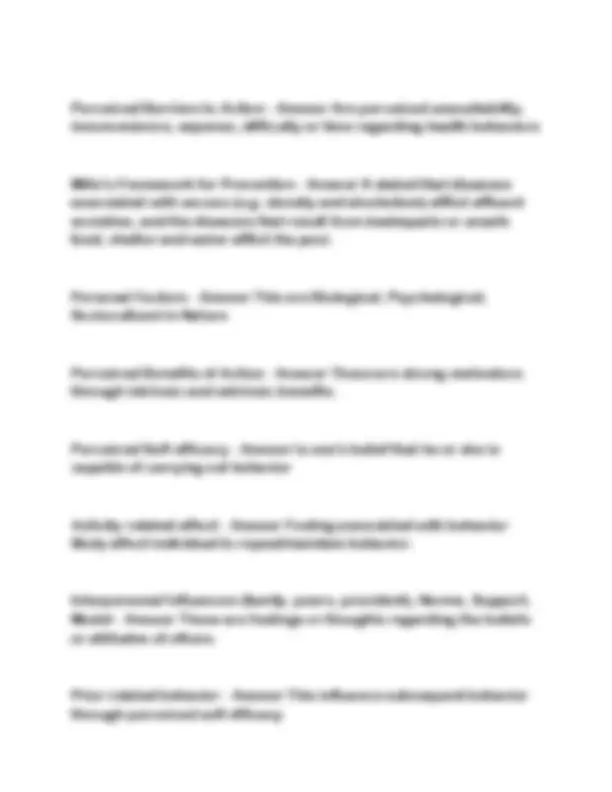
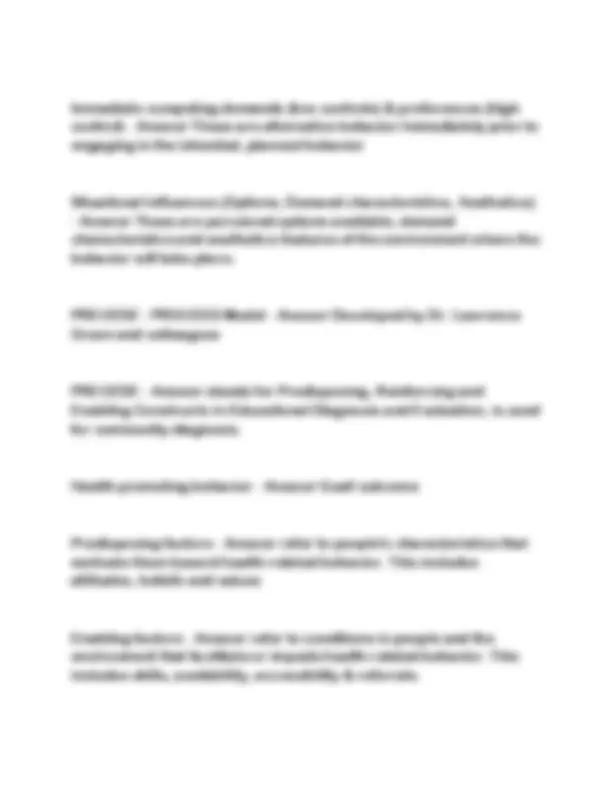
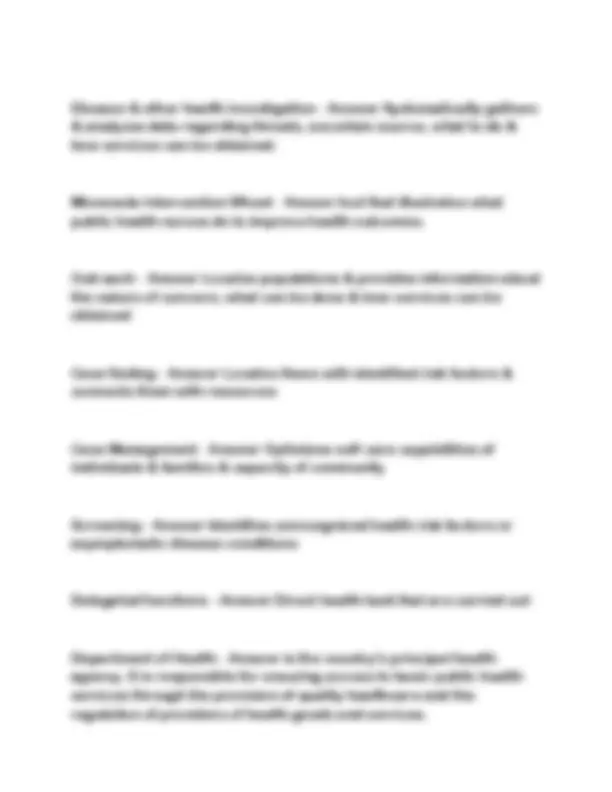
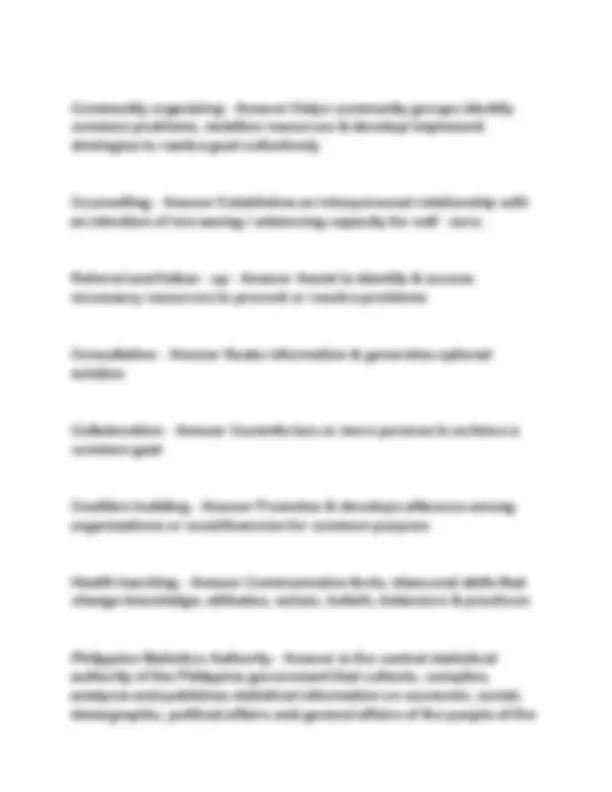
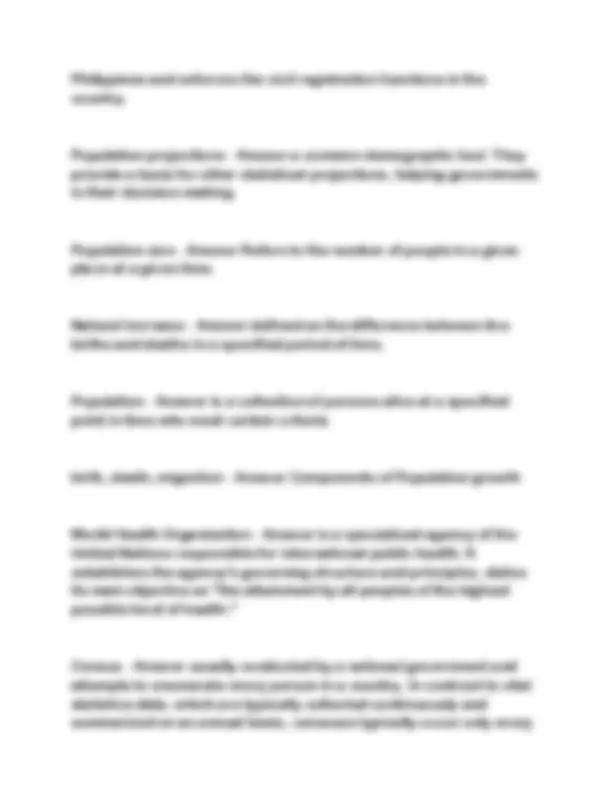
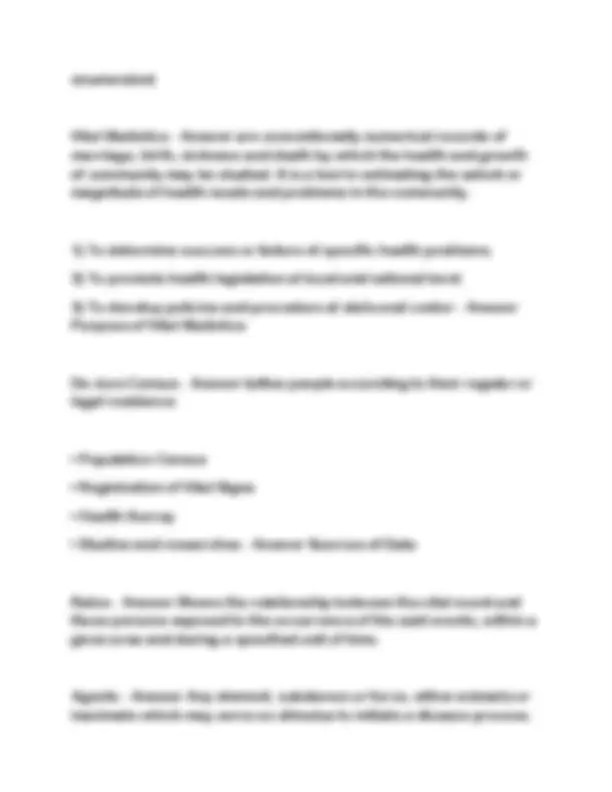
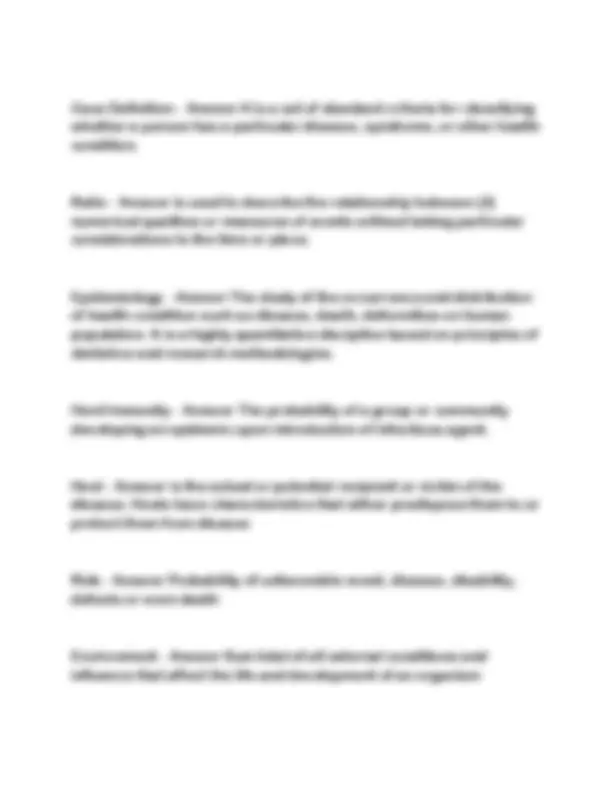
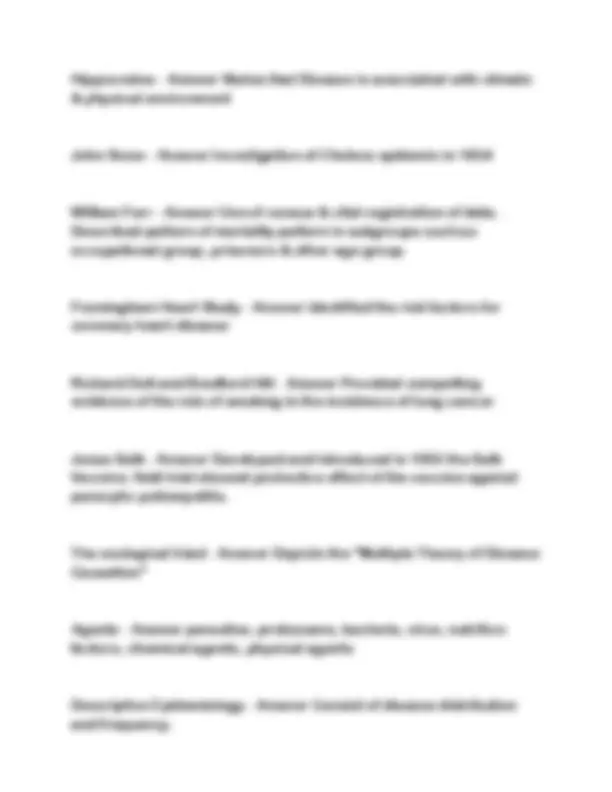


Study with the several resources on Docsity

Earn points by helping other students or get them with a premium plan


Prepare for your exams
Study with the several resources on Docsity

Earn points to download
Earn points by helping other students or get them with a premium plan
Community
Ask the community for help and clear up your study doubts
Discover the best universities in your country according to Docsity users
Free resources
Download our free guides on studying techniques, anxiety management strategies, and thesis advice from Docsity tutors
A comprehensive set of questions and answers related to community health nursing (chn) prelims exam. It covers various aspects of chn, including its philosophy, principles, features, and key models like the health belief model (hbm) and precede-proceed model. The document also explores the characteristics of a healthy community and the role of public health nurses in improving health outcomes.
Typology: Exams
1 / 17

This page cannot be seen from the preview
Don't miss anything!










Philosophy - Answer is defined as "a system of beliefs that provides a basis for and guides action."
WHO - Answer According to ______, CHN is a special field of nursing that combines the skills of nursing, public health and some phases of social assistance and functions for the promotion of health, improvement of social and physical conditions and rehabilitation of illness and disability
Margaret Shetland - Answer According to ______, the philosophy of CHN is based on the worth and dignity of a man
Community Health Nurse must be available to all.
In Community Health Nursing, the family is the unit of service.
There should be accurate recording and reporting in Community Health Nursing
The Community Health Nurse works as a member of the health team
The Community Health Nurse makes use of available community health resources - Answer Principles of Community Health Nursing
Jacobson - Answer According to ______, CHN is a learned practice discipline with the ultimate goal of contributing to the promotion of the client's OLOF (Optimum Level of Functioning) through teaching and delivery of care.
Republic Act 124 - Answer mandates that all schools are to provide school clinics for the treatment of minor ailments and emergency cases
Preventive Approach to health.
characterized by being population or aggregate - focused.
developmental in nature
With existence of prepayment mechanism for consumers of community health nursing services
Care for different levels of clientele - Answer Features of CHN
American Nurses Association (ANA) - Answer According to ______, CHN is "The synthesis of nursing practice and public health practice applied to promoting and preserving the health of the populations."
School Health Nursing - Answer Aims to promote the health of school personnel and pupil / students. It aims to prevent health problems that could hinder students learning and performance
Health Education, Physical Education Health Services, Nutrition Services, Counselling, psychological and social services Healthy School Environment, Health Promotion for Staff. The Family & Community Involvement - Answer Eight Components of School Health Services
Occupational Health Nursing - Answer It includes the prevention of adverse health effects from environmental hazards. It provides for and delivers occupational health and safety programs and services to clients.
Community Mental Health Nursing - Answer Unique clinical process that includes concepts of nursing, mental health, social psychology and community networks including social sciences. Focus is on the Mental Health Promotion.
Health Belief Model (HBM) - Answer Believed that individual must know what to do and how to do it before they can take action.
Perceived Susceptibility - Answer One's belief regarding the chance of getting a given condition
Perceived Barriers to Action - Answer Are perceived unavailability, inconvenience, expense, difficulty or time regarding health behaviors
Milio's Framework for Prevention - Answer It stated that diseases associated with excess (e.g. obesity and alcoholism) afflict affluent societies, and the diseases that result from inadequate or unsafe food, shelter and water afflict the poor.
Personal Factors - Answer This are Biological, Psychological, Sociocultural in Nature
Perceived Benefits of Action - Answer These are strong motivators through intrinsic and extrinsic benefits.
Perceived Self-efficacy - Answer Is one's belief that he or she is capable of carrying out behavior
Activity-related affect - Answer Feeling associated with behavior likely affect individual to repeat/maintain behavior.
Interpersonal Influences (family, peers, provident), Norms, Support, Model - Answer These are feelings or thoughts regarding the beliefs or attitudes of others.
Prior related behavior - Answer This influence subsequent behavior through perceived self-efficacy
Immediate competing demands (low controls) & preferences (high control) - Answer These are alternative behavior Immediately prior to engaging in the intended, planned behavior
Situational influences (Options, Demand characteristics, Aesthetics)
PRECEDE - PROCEED Model - Answer Developed by Dr. Lawrence Green and colleagues
PRECEDE - Answer stands for Predisposing, Reinforcing and Enabling Constructs in Educational Diagnosis and Evaluation, is used for community diagnosis.
Health promoting behavior - Answer Goal/ outcome
Predisposing factors - Answer refer to people's characteristics that motivate them toward health-related behavior. This includes attitudes, beliefs and values
Enabling factors - Answer refer to conditions in people and the environment that facilitate or impede health related behavior. This includes skills, availability, accessibility & referrals.
Geopolitical Community - Answer a community with defined geographical and jurisdictional boundaries, such as rural municipalities, towns or city communities. A is the procedure of systematically acquiring and recording information about the members of a given population.
population, location and social systems - Answer Factors Affecting Health of the Community
higher population density - Answer Factors that contribute to health problem in urban are
inequalities of resources and economic opportunities - Answer Factors that contribute to health problem in rural are
Social system - Answer the patterned series of interrelationships existing between individuals, groups and institutions and forming a coherent whole.
plants and fauna - Answer Other factors that affects health of community
family economic, educational, communication, political, legal, religious, recreational and health system. - Answer What includes in the social system
Surveillance - Answer Describes and monitor health events
Disease & other health investigation - Answer Systematically gathers & analyzes data regarding threats, ascertain source, what to do & how services can be obtained.
Minnesota Intervention Wheel - Answer tool that illustrates what public health nurses do to improve health outcomes.
Outreach - Answer Locates populations & provides information about the nature of concern, what can be done & how services can be obtained
Case finding - Answer Locates those with identified risk factors & connects them with resources
Case Management - Answer Optimizes self-care capabilities of individuals & families & capacity of community
Screening - Answer Identifies unrecognized health risk factors or asymptomatic disease conditions
Delegated functions - Answer Direct health task that are carried out
Department of Health - Answer is the country's principal health agency. It is responsible for ensuring access to basic public health services through the provision of quality healthcare and the regulation of providers of health goods and services.
Philippines and enforces the civil registration functions in the country.
Population projections - Answer a common demographic tool. They provide a basis for other statistical projections, helping governments in their decision making.
Population size - Answer Refers to the number of people in a given place at a given time.
Natural increase - Answer defined as the difference between live births and deaths in a specified period of time.
Population - Answer is a collection of persons alive at a specified point in time who meet certain criteria
birth, death, migration - Answer Components of Population growth
World Health Organization - Answer is a specialized agency of the United Nations responsible for international public health. It establishes the agency's governing structure and principles, states its main objective as "the attainment by all peoples of the highest possible level of health."
Census - Answer usually conducted by a national government and attempts to enumerate every person in a country. In contrast to vital statistics data, which are typically collected continuously and summarized on an annual basis, censuses typically occur only every
10 years or so, and thus are not usually the best source of data on births and deaths.
Sample Survey - Answer data gathered from small number of people proportionate to the general population
Age distribution - Answer also called Age Composition, in population studies, the proportionate numbers of persons in successive age categories in a given population
Rate of natural increase (RNI) - Answer a statistic calculated by subtracting the crude death rate from the crude birth rate of a given region in a specified period of time. This rate gives the public health nurse an idea of how a certain country's population is growing
Demography - Answer the study of the size, territorial distribution, and composition of population, changes therein.
Absolute Increase per year - Answer measures the number of people that are added to the population per year
Relative Increase - Answer Also known as the population growth rate, it measures the average yearly percentage change over the same time frame.
Crowding Index - Answer is an alternative measure of household crowding. It is defined as the number of usual residents in a dwelling divided by the number of rooms in the dwelling.
enumerated.
Vital Statistics - Answer are conventionally numerical records of marriage, birth, sickness and death by which the health and growth of community may be studied. It is a tool in estimating the extent or magnitude of health needs and problems in the community.
To determine success or failure of specific health problems.
To promote health legislation at local and national level.
To develop policies and procedure at state and center - Answer Purpose of Vital Statistics
De Jure Census - Answer tallies people according to their regular or legal residence
- Population Ce nsus **- Registration of Vital Signs
Rates - Answer Shows the relationship between the vital event and those persons exposed to the occurrence of the said events, within a given area and during a specified unit of time.
Agents - Answer Any element, substance or force, either animate or inanimate which may serve as stimulus to initiate a disease process.
Case Definition - Answer It is a set of standard criteria for classifying whether a person has a particular disease, syndrome, or other health condition.
Ratio - Answer is used to describe the relationship between (2) numerical qualities or measures of events without taking particular considerations to the time or place.
Epidemiology - Answer The study of the occurrence and distribution of health condition such as disease, death, deformities on human population. It is a highly quantitative discipline based on principles of statistics and research methodologies.
Herd Immunity - Answer The probability of a group or community developing an epidemic upon introduction of infectious agent.
Host - Answer is the actual or potential recipient or victim of the disease. Hosts have characteristics that either predispose them to or protect them from disease
Risk - Answer Probability of unfavorable event, disease, disability, defects or even death
Environment - Answer Sum total of all external conditions and influence that affect the life and development of an organism
Analytical Epidemiology - Answer Attempts to analyze the cause or determinants of disease through hypothesis testing
balance of host, agent, and environment factors - Answer What consists of the Epidemiological Triangle
Intervention or Experimental Epidemiology - Answer Answers questions about the effect of new methods for controlling diseases or for improving underlying conditions
Descriptive Epidemiology - Answer concerned with describing the frequency and distribution of disease in a given population. This is by observing & recording existing pattern of occurrence of disease.
Evaluation Epidemiology - Answer Attempts to measure the effects of different health services and program
Epidemic - Answer is a situation when there is a marked upward fluctuation in disease incidence.
Endemic - Answer Is habitual presence of disease in given population.
Sporadic - Answer disease occurs every now and then affecting small number of populations.
Pandemic - Answer a worldwide occurrence of disease.
Fomites - Answer articles that are easily contaminated by pathogens from the respiratory, intestinal tract and skin